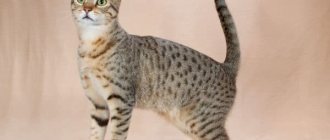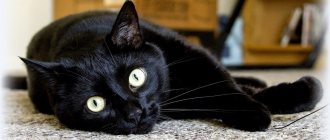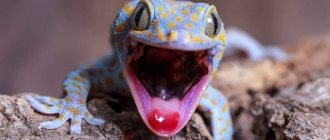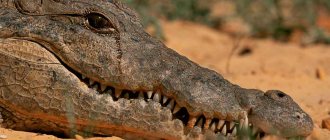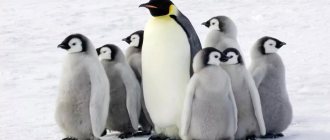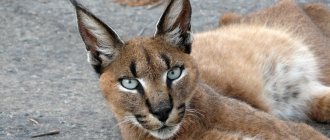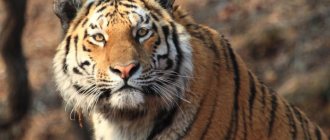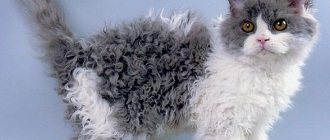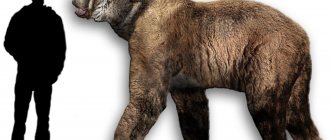When it comes to cats, what appears before your mind’s eye is a fluffy, affectionate creature with a soft and beautiful coat. This is exactly the image they answer longhaired cats
. Of course, cats with short hair or no hair at all occupy an equally honorable place in the cat world. But pets with long hair are a special caste.
The history of long-haired cat breeds goes back centuries. Nature originally endowed purring cuties with short fur. This evolutionary feature helped wild animals survive in difficult natural conditions. However, thanks to random mutations and targeted breeding work, cats with unusually beautiful long hair began to appear in the world. Moreover, the origin of each breed is individual and interesting.
Long or semi-long hair has always been a sign of nobility, royalty and chic. That is why the first beauties with unusual appearance, brought to Europe from Asia Minor in the 16th century, became the property of royalty.
To date, felinologists have recognized more than 30 breeds of cats with long fur. And the list is constantly updated with new varieties, which are gaining popularity every year. Many of the existing long-haired and semi-long-haired cat breeds were developed thanks to the persistent efforts of breeders over many years. Valuable long-haired kittens
are still under the care of nurseries and private hobbyists.
From the history of long-haired cats
Long-haired cat breeds first appeared on the European continent approximately in the mid-16th century. They were first learned about in Italy. Representatives of these breeds gained wide popularity after Cardinal Richelieu himself got himself a long-haired cat. For a long time, these animals, due to their rarity and high cost, were the privilege of only noble and wealthy people.
Until now, long-haired cats are extremely popular not only because of their attractive appearance, but also because they are rightly considered the kindest, most affectionate, tame and flexible. These pets become attached more to the owner than to the house, unlike most other cats.
Maine Coons
It is generally accepted that the homeland of Maine Coons is cold regions with harsh climatic conditions. This explains the presence of extremely thick and water-resistant fur in animals, large furry paws that make it easier to move on snow-covered surfaces, as well as massive fluffy tails that can be wrapped around to keep warm.
Breed overview
Weight : 4-8 kg
Body length : 91-101 cm
Physical characteristics:
- size – medium to large;
- wide chest;
- pointed ears;
- thick coat (short on the shoulders and belly);
- colors include more than 75 variations;
- eye color is predominantly green, gold or copper.
Officially recognized breeds of fluffy cats WCF – 1st and 2nd group
The Burmilla Longhair is a breed descended from the Persian and the standard Burmilla. The cats have the original chinchilla color and long hair. A kind, attentive, independent cat, loyal to all living things. Moderately sociable, preferring the “company” of toys or quiet observation of others.
The Munchkin Longhair (CFA recognized) is an unusual cat with short front legs and a habit of sitting in a marmot position. The breed has a friendly and sociable character, but can fight back if necessary.
Oriental Longhair (recognized by FIFe) is a breed with an oriental appearance and tabby color. The ancestors of the variety are standard Orientals, Siamese and domestic (aboriginal, mongrel) cats. Tailed animals are kind, faithful and too trusting, so much so that transfer to other hands can lead the animal to depression and even death “from boredom.”
The Japanese Bobtail Longhair (recognized by FIFe) is an impressively sized cat with the peculiarity of the absence of a tail (a congenital trait). The breed is people-oriented, sociable, and affectionate. The original trait is to raise one front leg while sitting.
Less common furry cat breeds recognized by the WCF
- York.
- Karelian Bobtail is long-haired.
- Cymric (FIFe recognized).
- The Kurilian Bobtail is long-haired (recognized by FIFe).
- Nibelung (CFA recognized).
- Ragamuffin.
- The La Perm Longhair (CFA recognized) is a cat with curly hair.
- Somalia (recognized by FIFe).
- Selkirk Rex Longhair (CFA Recognized).
- Chantilly Tiffany.
- The Ural Rex is long-haired.
- Highland fold (CFA recognized).
Signs about magical pets
There are a very large number of folk signs that are associated with these creatures. They say that if you get yourself such a pet, then happiness will undoubtedly come to your home. This is especially true for white pets with black and red spots. The reason for this is the meaning of the colors they possess. We suggest considering these notations:
- white color is sincerity, harmony and cleanliness;
- black color – protection from negative and dark emotions, as well as from bad energy;
- red color means wealth and, in addition, the expulsion of painful experiences and diseases.
In Japan, these cats are generally a talisman. Therefore, they have a custom of placing a figurine of such an animal at the entrance to the house.
This is interesting! Also in Japan you can find a figurine in the form of a welcoming cat, which attracts prosperity and harmony to the home.
In Muslim countries, they believe that a tricolor cat in the house protects the house from fires and other disasters. In Great Britain, it is also customary to decorate their homes for protection with talismans that look like these animals.
There is a rather interesting sign for brides. If such a cat sneezes in front of a bride who is putting on her wedding attire, then this is an indication that the girl will be happily married. According to legend, strong family happiness and true love await her.
This is interesting! Since calico cats are quite rare animals, they are highly valued on sea ships. This animal, according to superstition, brings good luck in sea voyages.
So, we have found out that tricolor cats can not only make your home bright, harmonious, bringing you well-being. They are also distinguished by their sociability, playfulness, sincerity and wonderful character. Such pets are suitable for any family and can satisfy any owner.
Care and maintenance
Caring for a Highlander is not difficult, but it does require regularity. In addition to providing a sleeping place, food bowls and a clean tray, the following main points of content should be paid to:
- Combing. Unlike the Persians, six British women do not roll, and therefore will not cause much trouble. It is enough to manipulate it twice a week with a rubber brush or a special mitten. During the molting period, brushing must be done daily.
- Bathing. You should be accustomed to this procedure from infancy, otherwise you won’t be able to wash an adult cat yourself: the British don’t like water. It is recommended to bathe up to three times a year with shampoos intended for British breed cats.
- Ear care. Three times a month, the ears should be examined and subsequently cleaned with a cotton pad soaked in a special solution.
- Eye care. The visual organs require daily examination. Contaminants are removed with a napkin intended for this purpose or with a simple one soaked in boiled water.
- Claw care. The cat does them on his own with the help of a scratching post.
- Dental care. For preventative purposes, it is enough to clean once a week with a soft brush and animal paste.
- Walks. With age, the British turn from active, playful kids into lazy cats. An inactive lifestyle can lead to obesity in your pet, so regular walking of the animal is necessary.
- Grooming the cat. In extreme cases, animals are prescribed haircuts: mats, partial mats in places for injections during treatment, advanced age of the pet, unable to care for the coat on its own.
Diet
Feeding the British cat is carried out with natural products or ready-made food, which are selected in accordance with the sex, age, health and character of the cat.
British Longhair cats have an excellent appetite. Combined with a sedate lifestyle, Highlanders can become obese. Controlling the size of portions and their calorie content (70 kcal per 1 kg of animal body weight) will help prevent possible health problems. Kittens are fed at least five times a day in small portions. By the year their number is reduced to two.
Natural food includes products: cereals, boiled boneless fish, lean meat, low-fat milk, quail eggs. Your pet will also happily accept raw meat. Various pickles, potatoes in any form, fatty meats, smoked foods, sweets, spicy and fried foods are excluded from the diet. In combination with natural nutrition, it is necessary to provide a vitamin and mineral complex designed specifically for long-haired cats.
Often, owners prefer feeding dry food. The choice is desirable in favor of premium products. With this method, you need to give your pet a bowl of water and change it daily.
Highlander cat photo:
Health and diseases
Highlanders have excellent health and good immunity. Proper care of your pet will eliminate possible illnesses.
- Tartar. A disease affecting all short-faced cats. Helping your pet brush his teeth will prevent tartar from forming.
- Obesity. Reasonable portion sizes, proper food, and encouragement to exercise will help control your pet’s weight.
- Allergy. An itchy pet with swollen and watery eyes is examined for the cause of the reaction. Symptoms are relieved by eliminating the allergen and taking antihistamines.
- Cold. A feature of the breed is sensitivity to cold. Cats get cold instantly. Eliminating the main cause in the form of drafts in the apartment will save your pet from frequent illnesses.
- Helminths. Not a single animal is safe from them. Annual deworming is recommended.
https://youtube.com/watch?v=fFl7XU0595U%3F
You should also not forget about visiting a veterinarian for the purposes of prevention and timely vaccination for the health of your pet.
Only one disease is incurable: hypertrophic cardiomyopathy. This is a hereditary disease associated with heart disease. In the early stages it is characterized by shortness of breath, rapid fatigue, in the later stages - damage to the hips and paralysis of the limbs due to blockage of blood vessels, pulmonary edema, and death. The disease can be detected using cardiac ultrasound. Such animals have not been allowed for breeding for a long time, and therefore the disease is unlikely.
https://youtube.com/watch?v=xMfD5MrDoQ0%3F
Care
Since Laperm is a cheerful and active cat, it is necessary to arrange the housing so that the pet can run freely and jump for pleasure.
It is important to have toys for your pet; mice, balls, teaser rods and other interesting and safe toys are good options.
Similar toys for dogs are also suitable.
Despite the fact that Laperm spends most of his free time from playing and exploring in the arms of his owner, you can get a bed or a house with a scratching post for your pet
It is important to ensure that your pet is not in drafts and does not overheat in the warm season
Be sure to examine your cat's eyes, nose, mouth, and ears daily and remove dirt if necessary. If your pet lives exclusively indoors, you can trim its nails. You can master this procedure on your own, but if you have doubts about your abilities, it is better to contact a veterinarian or a professional groomer (pet care specialist) so as not to harm your pet.
After walks in the fresh air and games, it is useful to conduct a full examination of the cat - gently and gently stroking the head, neck, paws, sides, stomach and back to assess the general condition. You need to understand whether there are any wounds or external parasites, and evaluate how the pet reacts to touch.
You should brush your cat's teeth at least once a week. This procedure helps remove plaque and prevents the formation of tartar, which leads to more serious health problems.
Regardless of whether the cat lives in the house or has access to the street, it is necessary to carry out deworming (treatment for worms) every 3 months; tablets, suspensions or drops are used for this. During the warm season, they are treated every month for external parasites. From the age of two months they begin to vaccinate and then receive vaccinations annually throughout their lives.
These cats are strong and rarely get sick, so there are no difficulties in caring for Laperm. However, to preserve the properties of wool, you must adhere to some rules.
You should not bathe your pet too often. Firstly, excessive water procedures remove the natural fat layer on the skin, which leads to dandruff, discomfort, and deterioration of the coat. Secondly, frequent moisturizing of the hair affects frizz and can straighten beautiful curls. If your pet is dirty, you can bathe it, but you should only use special shampoos for cats, taking into account the type of coat.
After water procedures, Laperma should be thoroughly dried with a towel, but you should not dry it with a hairdryer - this measure can damage the hair structure and reduce the degree of curliness by straightening the curls. You can also use dry shampoos.
You need to comb your pet at least 1-2 times a week, or more often, up to daily. This is especially true for long-haired pets. Although LaPerms' fur usually does not tangle, sometimes the hair can become matted and matted. A comb with rounded edges works best.
At the same time, if for some reason tangles appear on the cat’s fur, you should not cut them off with scissors. To eliminate them, there is an excellent tool - a tangle cutter. With its help you can easily deal with tangles of any size.
Don't forget to provide your cat with a tray with special filler in the same place she likes. She will not go into a dirty litter box and will use another place in the apartment for the toilet.
If you don't really like the daily, unpleasant routine of washing a dirty litter box, you can try to retrain your cat to go to the regular toilet in the toilet.
Somali (Somali)
The long-haired version of the Abyssinian cat was probably developed during World War II. Due to the decline in the number of Abyssinians, breeders tried to increase their numbers by introducing long-haired individuals. Only since 1960-1970. Somalis began to be identified as a separate breed.
Breed overview
Weight : 2.7-4.5 kg
Body length : 38-45.7 cm
Physical characteristics:
- strong body of medium size;
- pointed ears;
- narrow muzzle, like a Persian cat;
- color: many variations, including brown, red, blue, gray, etc.
Turkish Angora
Appearing in Turkey in the 15th century, representatives of this breed were for some time considered the only owners of both white color and blue or green eyes; also, for many years, all long-haired cats were called Angoras.
It is now generally accepted that Turkish Angora wool can come in a variety of colors and patterns.
Breed overview
Weight : 2.2-4 kg
Body length : 30.5-45.7 cm
Physical characteristics:
- long, slender and graceful body;
- pointed ears;
- long and silky coat;
- Color: Many color and pattern options including white, lilac, chocolate, calico, tabby and more.
Influence of genes
It is known that cats have a pair of X chromosomes (XXY), and cats have X and Y chromosomes (XY). The first of them is responsible for the appearance of black (eumelanin pigment) and red (pheomelanin pigment) in the color of the animal; white is encoded by another chromosome. Due to the presence of two X chromosomes in cats, it is possible to observe the simultaneous appearance of black and red color on a white background.
There are also cases of genetic disorders in cats when they have XXY chromosomes, as a result of which they are sterile. The gene linked to the sex of the animal, called “orange,” is found only in cats and hamsters of the Syrian breed.
One of its alleles, O, blocks the synthesis of black pigment, and orange appears in color, but the other does not block it. All specialized skin cells that produce melanin are melanocytes; if they come from a cell with the active O allele, they will appear as red hair. This gene was discovered relatively recently, in 2010, and therefore its study is still ongoing.
At the moment, scientists are faced with the fact that it is impossible to clone calico cats; their color cannot be reproduced due to the inactivation of one of the X chromosomes, reports E. Zernglow, the company's leading specialist in the field of cloning. Nature has made sure that each representative of the feline species has its own unique, individual color.
Did you know? Genetic anomalies among cats are so rare that for every 3 thousand tricolor females there is only one cat, which, moreover, cannot have offspring.
Ukrainian Levkoy
These exotic creatures were bred about 10 years ago in Kyiv. The Ukrainian Levkoy is the result of crossing the Don Sphynx with Scottish Fold cats. The end result was cats with the same body contours as sphinxes, but with funny downward-curved tips of their ears.
Ukrainian Levkoy
Sometimes Levkoys can be covered with light fluff on the body - this cannot be called full-fledged wool, so this fluff is called brush (translated from English as “brush”).
Laperm
Known for its striking appearance, the Laperm breed is relatively new; its origin dates back to 1982. Animals of this variety have long hair that curls tightly around the neck, ears and tail, as well as a fluffy tail in the shape of a bottle brush.
The unusual “fur coat” of representatives of the Laperm breed is the result of a genetic mutation associated with the need for the animals to develop curly hair; This feature was then propagated by breeders.
Breed overview
Weight : 2.7-5.5 kg
Body length : 30.5-45.7 cm
Physical characteristics:
- medium-sized, strong body;
- tightly curled hair around the neck, ears and tail;
- Color: Various variations, but most often tortoiseshell, calico and tabby.
Burmese
Although the Burmese's coat can be dyed in 6 colors and have 2 patterns, almost all representatives of the breed have blue eyes, and their four paws are “shod” in white slippers.
The history of the breed is unknown, but there are suggestions that Burmese cats were imported to France, where they were crossed with Siamese.
Breed overview
Weight : 4.5-5.4 kg
Body length : 38-45.7 cm
Physical characteristics:
- strong medium or large body;
- pointed ears;
- silky long hair;
- color: “seal”, blue, chocolate, red, cream, tortoiseshell, with dark areas or spots, like a lynx.
Persian
Persians are famous for their long, glamorous coat, flattened muzzle, and bright eye color. These cute creatures not only have a charming appearance, but also a good character. Born to cuddle, they are extremely calm, sweet and inactive. Despite their sedentary lifestyle, which does not cause trouble to their owners, cats require careful care. If you neglect to regularly comb the fur, it quickly becomes tangled, resulting in tangles.
Breed overview
Weight : 3-5.5 kg
Body length : 35.5-45.7 cm
Physical characteristics:
- strong, medium-sized body;
- flattened muzzle;
- bright round eyes;
- long silky coat;
- color: plain, two-color, striped, calico (black-red-white), etc.
How to choose the right kitten
The paradox of breeding: a long-haired baby can be born not only to Highlanders, but also to short-haired British women - in this case it will be considered as a breed defect and will cost much less. The average price of a show-class kitten is one and a half to two thousand dollars. For that kind of money (or slightly cheaper), scammers can offer you a charming furry “with documents” that will have nothing to do with the breed.
British Longhair kitten - isn't he adorable?
Study the breed standards - after all, at first glance, all fluffy kittens are similar. The British Longhair kitten is most similar to the British Shorthair kitten, which is less difficult to identify. Just imagine the baby being offered to you in a short fur coat - this will help.
British kittens, long-haired and short-haired, look like twin brothers in different coats
But it is more correct, of course, not to rely on your powers of observation, but to buy a baby from a reputable nursery and enter into an official agreement with the breeder, which can largely guarantee the breed of your baby and his hereditary health.
British by character, what is he like?
In general, when purchasing this breed of cat, you can be completely calm that it will not present any surprises, since by nature it is a calm, peace-loving pet, with an easy-going, good-natured disposition.
They like to retire to their own place where they can lie for some time, especially when they are attacked by a slight attack of melancholy and it is best not to disturb them at this time, let the cat be alone, rest, and soon she will again begin to seek the attention of her owner
They are also calm in the morning before they are fed. Representatives of this breed will not scream at the top of their lungs until they are fed, but will wait patiently, and occasionally you can hear a short “Meow” from them.
- The British Longhair cat in its youth is a rather playful animal and it doesn’t matter to her who she does it with, either with her owner, or she can keep herself busy on her own, provided she has a toy (ball, toy mouse).
- With age, they calm down a little, their motor activity decreases, so it is ideal for both families with children and the elderly. The British get along well with children, provided they do not bother them.
- Therefore, before bringing this breed of cat into the house, you should first talk with your children about the fact that they cannot tolerate excessive attention, so you should not put them in close hugs.
Also, cats can get along with another pet in the house, including a dog, provided that this happens at a younger age for both, then you can count on their peaceful coexistence.
Features of caring for cats with long hair
All cats, especially long-haired ones, need coat care. This will not only maintain the appearance of the animal, but also prevent many health problems.
Main features of long hair care:
- the coat must be combed regularly;
- the comb must have metal teeth;
- Combing should begin with collecting fallen hairs, especially when the cat begins to shed;
- First you need to comb your pet along the hair growth, and then against it, moving from the tail.
The main thing in the combing procedure is to have patience. And this applies to both the owner and the pet. It is best to accustom long-haired kittens to care from early childhood and then there will be no problems with care in the future.
Caring for a long-haired cat
Bathing
Bathing is an important part of hygiene and care for long hair. It is necessary to accustom a kitten from an early age. Be sure to use special shampoos for animals with an acidity that is suitable for their coat and skin. It is never recommended to use human detergents, as they contain substances that can harm your pet.
Important! Long-haired cats should be bathed no more than once every 2-3 weeks, since washing removes a thin protective fat layer from the coat, which protects the skin and coat from unwanted environmental influences.
Nutritional Features
Proper nutrition is the key to the health and beauty of your pet. Long-haired cats need a special, balanced diet. The food should be varied. It must include meat, fish, vegetables, cereals, and dairy products. Cat nutrition is selected individually and the energy value of products depends on:
- body weight;
- general physiological condition of the pet;
- breed characteristics;
- activity level.
A balanced diet will allow the stomach to work properly and also ensure good coat condition.
Cat food
Long-haired cats may differ in origin, size, and character. Although they are very beautiful, they are not suitable for everyone; for example, people suffering from allergies should not have such an animal.
Interesting Facts
- The famous three-colored cat of Rus' is Bayun;
- The flamboyant Cardinal Richelieu kept a large number of colored favorites;
- A popular Japanese souvenir is a three-color “maneki neko” with a raised paw;
- The official animal in the US state of Maryland is the “tortoiseshell” cat;
- 99.9% with this coloration are females;
- Seals with three coat colors are infertile;
- Dilution will not work, stained coloring is a gift of nature;
- On the island of Honshu in 2007 they wanted to close the railway station. The situation was saved by a cat who was appointed boss. The cute creature greeted people, and soon the flow of passengers increased by 16%.
Norwegian forest
The Norwegian Forest Cat, also known as the Wegi, has a natural origin dating back to Viking times. Similar to the Maine Coon, the Vega's past is associated with cold climates; Representatives of this breed have thick, water-resistant fur. It is recommended to bathe Norwegian cats only in exceptional cases (if the pet is very dirty or for medical reasons).
Breed overview
Weight : 5.9-9 kg
Body length : 30.5-45.7 cm
Physical characteristics:
- a large, strong body with a very thick “fur coat”;
- large soft paws;
- long fluffy tail;
- color variations: white, black, red, cream, cinnamon (red-brown, cinnamon-colored), striped.
If you think that the Himalayan cat is a little reminiscent of Persians and Siamese, you are one hundred percent right - this breed is a hybrid of Siamese and Persian. As a result of mixing two popular varieties, a magnificent animal appeared with the “fur coat” and eye color of the Siamese, as well as the long and silky hair of the Persians.
Himalayan cats are cute and playful, but do not be fooled about their carefree life together - beautiful creatures require regular care, because... their fur is prone to tangling and matting.
Breed overview
Weight : 3-5.5 kg
Body length : about 46cm
Physical characteristics:
- medium to large body size;
- wide chest, round belly;
- muscular build;
- animals often look larger than they actually are;
- color: cream, gray, blue and chocolate with dark areas.
